Home → Fish & Wildlife → Wildlife → Living with Wildlife → How to Avoid or Resolve a Wildlife Conflict → Species-Specific Tips
Species-Specific Tips
The first step to resolving wildlife conflicts is to modify your own behavior. Wildlife seek basic requirements for survival such as food, water, and shelter. Preventing or removing access to these attractants is the first essential step to resolving a wildlife problem.
To learn more about the species living near you and additional ways to encourage them to move on, please select a species below.
On this page:
Bats

Bats are highly beneficial to people, and the advantages of having them around far outweigh any problems you might have with them. As predators of night-flying insects (including mosquitoes!), bats play a role in preserving the natural balance of your property and neighborhood. There are eight bat species in Maine. Some bat species hibernate in Maine during the winter, called hibernating bats, and other bat species migrate south for the winter, called tree bats.
For some people bats don't present a problem. For others, bats can be a worry, especially when they become unwanted guests in an attic, inside a wall, or in living space.
Learn How to Prevent and Resolve Conflicts with Bats
Beavers
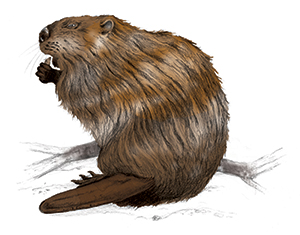
Beavers are the only species that can create its own habitat, and it does so by impounding water. In doing so, beavers are considered a keystone species, meaning their presence in nature greatly impacts other wildlife, providing quality wetland habitat for many dozens of other species of wildlife. Despite an appreciation for these animals and our best intentions to live with them, beavers can become a problem if their eating habits or dam/den building activity flood or damage property.
Learn How to Prevent and Resolve Conflicts with Beavers
Birds of Prey

Photo by Peter Green
Maine is home to many species of birds or prey, also known as raptors, including owls, falcons, hawks, eagles, harriers, osprey, and vultures. Birds of prey or raptors have hooked beaks for tearing flesh, sharp talons for gripping, wide wings and light bodies for hunting, and feathers specifically designed for fast, quiet flight. Humans have been captivated by the impressive flight skills and hunting prowess of raptors. Declines in many raptor populations and conservation efforts to aid them have further elevated our awareness.
Learn How to Prevent and Resolve Conflicts with Birds of Prey
Black Bears
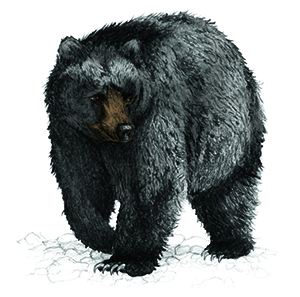
Maine is home to the largest population of black bears in the eastern United States. Our bears are most active between April 1 and November 1.
When natural foods are scarce, especially in the spring or dry summers, bears will venture into backyards and fields in search of easily accessible food such as bird feeders, garbage, grills, and pet foods.
Learn How to Prevent and Resolve Conflicts with Black Bears
Bobcats
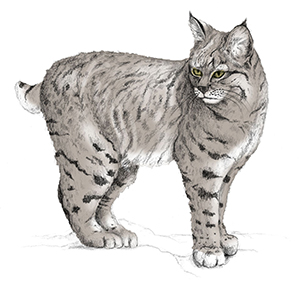
While bobcat are primarily nocturnal hunters, seeing a bobcat during daylight hours is not uncommon and should not be alarming. Navigating deep snow is challenging for bobcats, so they will move closer to towns and residences in search of accessible food. Bobcats use all habitats found throughout their range in Maine, making them versatile and opportunistic. As a generalist predator, bobcats keep small rodent populations in check, and also consume turkeys, porcupines, and even deer.
Conflict resolution
Always start with the standard steps to avoiding conflicts and make sure you have eliminated access to food, shelter, and water. Bobcats can climb or jump over fences, so prevent access to birds in their night roosts through enclosed pens with one-inch chicken wire placed over a sturdy wooden framework. Installing electrified fences on existing fence posts and other structures can protect against climbing.
Learn more about fencing options here.
Canada Geese

Canada geese are among the most familiar birds in Maine. They are a source of recreation for bird watchers and hunters and symbolize nature for many people. It is challenging to miss the clear honking call of Canada geese as they fly overhead in their V-shaped formation. Geese are known seed dispersers, providing important dispersal of vegetation to grow in new areas once digested and excreted by the animal. Never feed geese and consider changing the habitat to prevent conflict.
Learn How to Prevent and Resolve Conflicts with Canada Geese
Coyotes
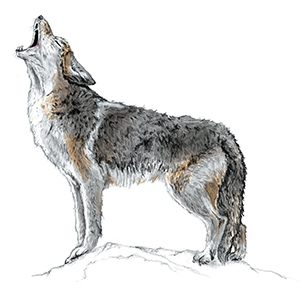
Coyotes are known to seek food at any time of the day, often taking advantage of twilight and nighttime, but it is not abnormal for coyotes to be out during daylight hours.
Maine was once occupied by large predators such as wolves and mountain lions. However, over time, those species were extirpated from Maine, opening an ecological niche for a new predator to move in. Coyotes are opportunistic hunters and scavengers, highly intelligent, and provide several valuable services to Maine’s wildlife. Coyotes now fill a critical role in Maine as predators, assisting in the maintenance of a healthy ecosystem. Coyotes prey on a wide variety of species including small mammals, snowshoe hare, turkeys, and deer. Although a predator, coyotes also take advantage of fruits and berries when they are in season.
Conflict resolution
Always start with the standard steps to avoiding conflicts and make sure you have eliminated access to food, shelter, and water. If coyotes are causing conflict around your home, it can be very difficult to identify the specific individuals causing the problems. If killed, new coyotes quickly replace the removed individuals. Ensure prevention by removing attractants such as pet food and garbage. Small pets can be viewed as prey by predators, keep your pets leashed and under control. Keep your livestock safe by using predator-proof pens, electric fencing, and/or guard animals. Also, coyotes can be very protective of their den when they are raising their pups (typically April-August). Keep dogs leashed and under control to prevent conflicts with coyotes.
Hazing
Be loud and large. If the coyote has not experienced hazing before, they may not run away immediately, it does not mean it is sick or rabid. You may need to increase the intensity of noise by waving your arms and yelling or using other loud noises. Alternatively, install a commercial device, such as the Coyote Roller, to prevent coyotes from being able to get the foothold necessary to hoist themselves over a fence.
Learn more about fencing options here.
Deer
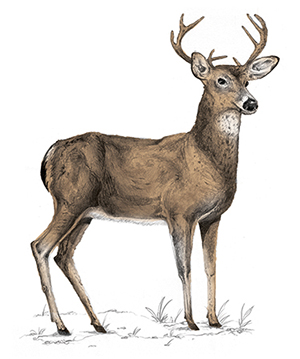
White-tailed deer are one of the most recognized mammals in Maine. Deer are seen most often at dawn and dusk, but often maintain a presence during daylight hours. With a prolific population in central and southern Maine, deer support one of the greatest hunting opportunities in our state. Deer are important seed dispersers, browsing on vegetation and depositing the seeds in their feces miles away, encouraging growth in other areas. In addition to having a significant influence on plant communities, deer are also important prey to lynx, bobcat, and coyotes in the state of Maine.
Conflict resolution
Deer are known for entering and consuming vegetation around the home or in gardens. To prevent access to certain areas, consider installing a fence. Learn how to prevent and resolve conflicts with deer.
Learn How to Prevent and Resolve Conflicts with Deer
Fisher
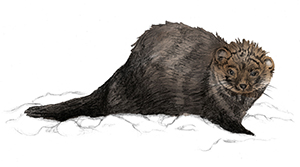
Fisher are an elusive species. Even though they are active year round, they are rarely seen. Fisher hunt both on the ground and in trees seeking small mammals, squirrels, snowshoe hare, and porcupines. As an exceptional predator, fishers help manage rodent populations to prevent them from becoming a nuisance.
Conflict resolution
Always start with the standard steps to avoiding conflicts and make sure you have eliminated access to food, shelter, and water. Keep food and shelter unavailable by securing garbage, keeping grills and pet food unavailable and clean, and removing seeds from under bird feeders. Keep pets inside at night and secure poultry in fenced-in areas. Learn more about fencing options here.
Foxes
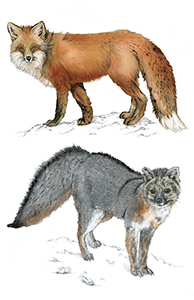
Maine has two species of fox, the gray fox occurs primarily in southern and central Maine and the red fox occurs statewide. Although foxes are primarily nocturnal, including hunting during dusk and dawn, it is not unusual to see fox during the day and it is not a cause for concern. Especially during the spring and summer months when rearing pups, fox may be looking for food mid-day. And remember that their fur coats are much thinner and patchier in the summer, especially for mother foxes who have put most of their energy into raising young.
Observing the behavior of a fox and her kits is enjoyable and safe when distance is kept. Fox are omnivores and eat a highly varied diet, feeding primarily on a number of small rodents. For a homeowner, they are an excellent predator to keep around, as they control mice, moles, and ground squirrels. Maine residents occasionally have the opportunity to observe a fox den near their homes. While the female will watch young kits around the den, the male will often hunt to provide food. Kits normally leave the den around seven months of age.
Conflict resolution
Always start with the standard steps to avoiding conflicts and make sure you have eliminated access to food, shelter, and water. If you want to encourage foxes to move from their den, pour bleach or ammonia at the entrance of the den, leave a portable light on, or a radio on overnight. This type of hazing will encourage them to move to an alternative den.
Hares & Rabbits
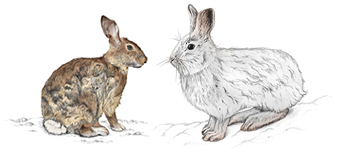
Maine is home to two rabbit-like species, but only one of them -- the New England cottontail, is a true rabbit. The other is the snowshoe hare. Snowshoe hares are larger than New England cottontails, have longer ears, and much longer feet. Probably the most recognizable difference between the two species is that snowshoe hares turn white during the winter while New England cottontails remain brown all year long. In the southern area of Maine, it’s important to recognize that New England cottontail are endangered and protected, so be weary of removal attempts. Rabbits and hares are strictly herbivores, meaning they only eat vegetation such as dandelions, grass, and new growth on woody plants. Rabbits are often a source of food for a number of predators such as owls, hawks, coyotes, foxes, weasels, mink, fisher, marten, lynx, and bobcats.
Conflict resolution
Placing fencing around gardens is the best way to exclude unwanted critters such as rabbits and hares. Learn more about fencing options here.
Barriers
In some cases, protecting individual plants may be more practical than excluding animals from an entire area. When placed over seedlings, commercially sold cloches or one-gallon plastic milk containers with the bottom cut out provide protection from animals as well as late frosts.
One-inch mesh chicken wire can be cut and formed into cylinders and placed around plants needing protection. Bury the bottom of the cylinders three inches below the soil line and brace them away from the plants so animals cannot press against the cylinder and nibble through the mesh. Inspect these barriers regularly to keep the area inside the barriers clean of leaves, weeds, and other debris, which can hide damage caused by mice and voles.
Hazing and repellents
Visual scare tactics including Mylar tape, party balloons, and pinwheel devices have limited usefulness in discouraging rabbits or hare, particularly in urban and suburban areas where the animals quickly get used to them. Ultrasonic units, which rely on sound waves, have not been proven effective. A dog can help keep hares away, especially if it is outside and awake at night.
Plants may also be protected with commercially available or homemade taste repellents that render the treated plant inedible. Research has shown that repellents with putrescent whole-egg solids can reduce browsing by hares. Apply repellents before damage occurs and reapply frequently, especially after a rain, heavy dew, sprinkler irrigation, or when new growth occurs. In all cases, follow the label directions. Many repellents cannot be used on plants or plant parts to be eaten by humans.
Learn more about Hares & Rabbits
Muskrats
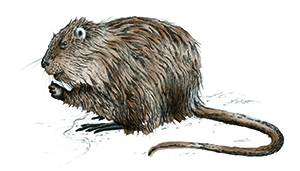
Muskrats are most active in late afternoon and after dusk but are seen during daylight hours as well. They get their common name from their resemblance to stocky rats and from the musky odor that they produce with their scent glands. They are found throughout still or slow-moving waterways, including marshes, beaver ponds, reservoirs, and marshy borders of lakes and rivers. Muskrats make a valuable contribution to aquatic communities. By harvesting plants for food and den sites, they create open water for ducks, geese, shorebirds, and other wildlife. In addition, a variety of animals – including snakes, turtles, frogs, ducks and geese – use muskrat lodges and platforms to rest and nest.
Conflict resolution
Most damage from muskrats are from burrowing and digging that can weaken dikes and dams. To make areas less attractive to muskrats, try to make the slopes gentle rather than steep. You can also contact your local wildlife biologist to discuss possible controlled burns to reduce vegetation that the muskrat relies on.
Opossums
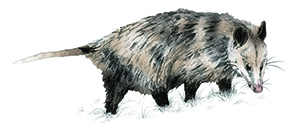
Opossums are poorly insulated with fur and have inadequate thermoregulation, often leading to frostbite on their ears and tails. For this reason, it is not uncommon to see opossums near human structures in an attempt to stay warm during winter months. Opossums are one of Maine’s most unique species of wildlife, fulfilling the only marsupial role in the state. They are limited by temperature and snow depth, keeping their range in Maine to the southern and central portion of the state. Opossums are omnivores, consuming both meat and vegetation when the opportunity presents itself.
Conflict resolution
Always start with the standard steps to avoiding conflicts and make sure you have eliminated access to food, shelter, and water. By taking these standard steps, opossums will typically move on to another area.
Raccoons

Raccoons are typically more active at night, or nocturnal, though seeing a raccoon during the daytime does not suggest illness. Raccoons are an extremely versatile species with a keen sense of hearing and have highly developed forepaws featuring five dexterous toes, allowing them to climb with ease and grasp and manipulate food and other items with their paws. Raccoons will eat just about anything, but are particularly fond of creatures found in water, such as clams, crayfish, frogs, fish, and snails. They also consume insects, slugs, dead animals, birds, fruits, vegetables, nuts and seeds. Raccoons play a role as predator, prey, and seed disperser.
Conflict resolution
Always start with the standard steps to avoiding conflicts and make sure you have eliminated access to food, shelter, and water. If there is no access to food or shelter raccoons will soon move on.
Skunks
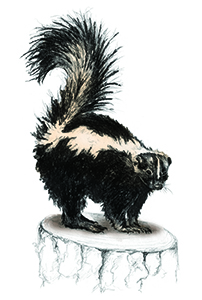
Skunks are a common species in Maine, occurring through most parts of the state, preferring open fields, pastures and crop lands. While you can see skunks during the day, it is most common to see them at night. Skunks are well known for their pungent adaptation with the help of enlarged scent glands, though are often mild-tempered and attempt to avoid spraying unless threatened, as it can take up to 10 days before the skunk can spray again.
Skunks are highly opportunistic, often feeding primarily on insects during spring and summer months, providing important insect control. During winter months, skunks often turn to consuming small rodents such as mice and voles. Skunks also provide an important food source to predators such as owls, eagles, bobcats, coyotes, foxes, and others.
Conflict resolution
Always start with the standard steps to avoiding conflicts and make sure you have eliminated access to food, shelter, and water. Skunks normally occupy a den site for only two or three consecutive nights. However, during the mating and nesting season, females are attracted to warm, dry, dark, easily defended areas, and will remain longer if the setting remains favorable. Occasionally a skunk will find a suitable den site in or under a building. Be sure to prevent access to areas under porches, stairs and in garages where skunks may search for shelter and food.
Prevent damage to lawns
Because lawns—especially newly created ones—are often heavily watered, worms and grubs inhabit areas just under the sod, attracting skunks and raccoons. Skunks tend to dig one- to three-inch deep holes only where a grub is located; raccoons tend to roll or shred the sod in their search. The Department does not recommend using pesticides to kill worms and grubs because these chemicals can have a toxic effect on the environment, people and animals.
To prevent digging, lay down one-inch mesh chicken wire, securing the wire with stakes, heavy stones, or other heavy objects. Alternatively, sprinkle cayenne pepper or a granular repellent such as Repel® (a commercial dog and cat repellent available at most pet stores or garden centers) over small areas during dry weather.
You can also surround the area with a two-foot tall chicken-wire fence; support the wire with sturdy wooden stakes or fiberglass stakes every four to six feet. To prevent skunks from going under the fence, stake the bottom of the wire flush to the ground or line the bottom of the fence with bricks, fence posts or similar items. Or, make a one-foot wide wire apron on top of the ground on the skunks' side of the fence; secure the apron firmly with rocks or stakes.
Learn more about fencing options here.
Squirrels
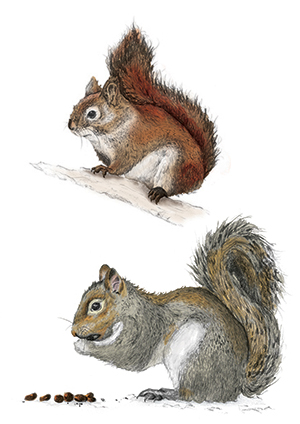
Squirrels and chipmunks are among the most common wildlife species in Maine. They are tree dwelling rodents that are most active during the daytime. Squirrels provide a valuable resource in shaping plant composition. They often take nuts and burrow them into the ground, creating an opportunity for plants to germinate. Squirrels are also a considerable prey source for carnivores since they are so abundant.
Conflict resolution
While many people enjoy the presence of squirrels and the opportunity to observe their behavior, they can become an issue if they take residence inside your home’s attic or other locations. Damage can occur when squirrels gnaw an entrance into your home, nest and damage insulation, or chew on wires potentially creating fire hazards. Because squirrels are so abundant, removal is not a permanent solution since other squirrels will come take their place.
Prevent damage by trimming branches near your home, eliminating easy access to roofs. Make sure eaves are tightly closed, replace rotten boards, and cap chimneys to prevent entry.
To prevent squirrels from consuming bird feed and harassing birds, be sure to regularly clean bird seed from the ground and purchase squirrel-proof bird feeders.
Learn more about eastern Gray Squirrels Learn more about Red Squirrels Learn more about Flying Squirrels
Turkeys

Turkeys are one of Maine’s greatest success stories. A once extirpated species from the state, MDIFW successfully transplanted a small group of turkeys to southern Maine. Wild turkeys are opportunistic feeders and eat a wide variety of grasses, seeds, berries, leaves, insects, worms, snails, and small reptiles and amphibians. Turkeys provide an important form of seed dispersal on the landscape, and the eggs and poults are often prey to larger predators. In addition, turkey provide economic value to the state through hunting.
Conflict resolution
First, do not feed turkeys, that provides an attractant. If problems are already happening, hazing turkeys is usually a good way to prevent them from settling into an area. Chasing them while waving your arms, clapping your hands, and yelling at them should assist in the flock fleeing. Loud noises, including a loud dog bark, can help.
Woodchucks
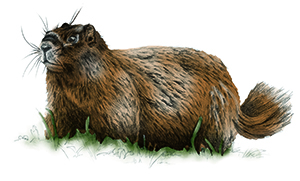
Woodchucks, also called groundhogs, inhabit both urban and suburban yards, fields, meadows, woodland clearings and are frequently seen in grassy areas along highways. Woodchucks are commonly seen sleeping or basking in the sun and feeding during the early morning and late afternoon hours.
Woodchucks provide soil aeration, seed dispersal, and creates new habitats from abandoned dens for other wildlife. Additionally, woodchucks are a common prey source to a number of carnivores.
Conflict resolution
Woodchucks may eat plants and vegetables from your gardens, learn more about fencing options here.